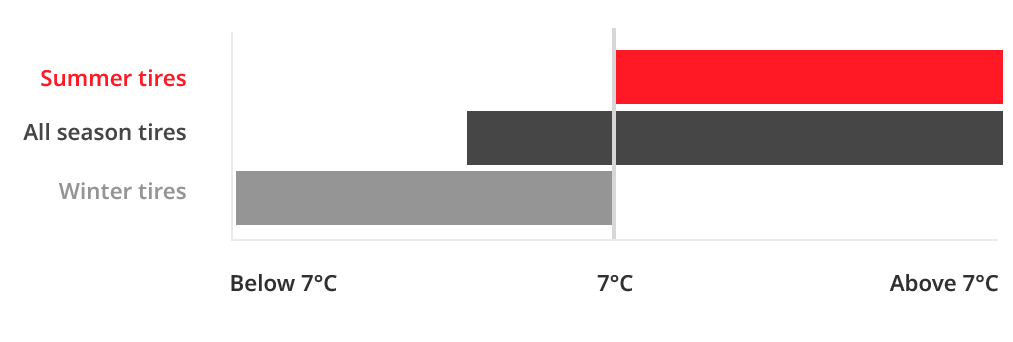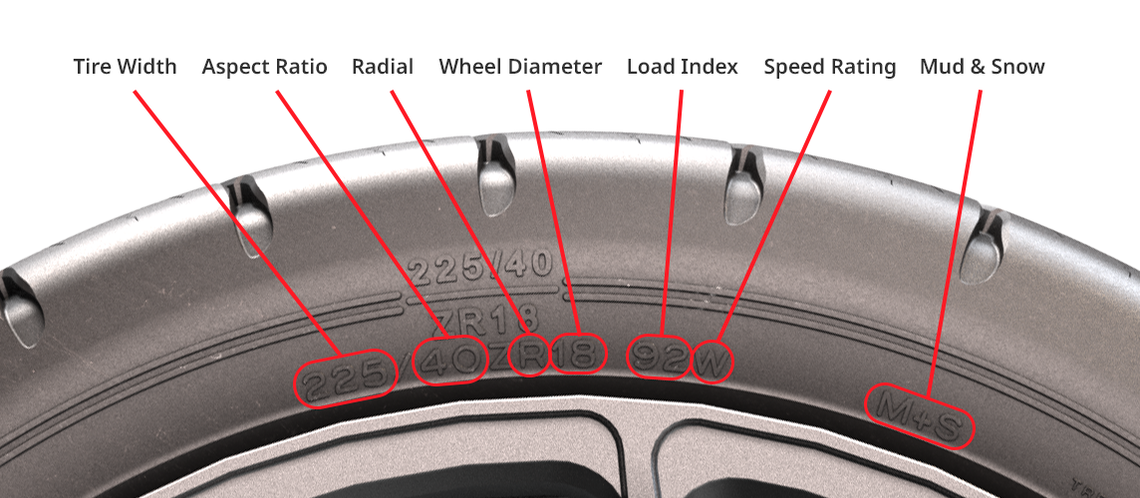CHOOSING THE RIGHT TIRE
CHOOSING THE RIGHT TIRE
Peak Performance for Every Season
We stand behind every tire we make, and we want to be sure you select the one that’s right for your vehicle and driving conditions. After all, a driver in New York needs a very different tire than a driver in Nevada. We want to help you buy the right tire for your driving conditions, so your rides feel better and your tires last longer.
All season Icon

All-Season Tires
Perform best in warm weather conditions and reliably in moderate winter conditions.
Not ideal for those who live where the winters are consistently harsh.
Winter - Snow Icon

Winter Tires
Designed specifically for icy, cold, snowy, wet conditions, but also work well in dry conditions.
Should be removed when the ambient temperature is consistently above 45 degrees F.
Summer Tires Logo

Summer Tires
Designed to perform in warm weather.
Should be removed if it’s consistently below 45 degrees F.
tire season graph

What Do You Want in a Tire?
If you’re looking for comfort and handling...
Touring tires are the best choice for a smooth, quiet ride and good handling on wet and dry pavement.
If you drive a sports car or want handling and performance...
For a sports car or high-performance vehicle, high-performance tires are designed for higher speeds.* They’re also good for cornering, and they handle wet and dry conditions well.
If you drive a pick-up truck or SUV...
Light truck tires help with durability and traction in off-road conditions while SUV tires are ideal for on-road comfort. So, pick your tire based on how you use your vehicle.
Check Your Tire Specs
Tire size tells you more than how big your tire is—it tells you what your tire is capable of. You can locate your vehicle's original tire size in your owner's manual or on the tire label found on the driver's doorjamb, inside glove box lid, or inside the fuel hatch. If in doubt, consult your local Uniroyal tire retailer or check your sidewall.
TIP:
Never choose a tire that is smaller than the tire that came with the car. If you are interested in a size other than your vehicle's original equipment or want to upgrade, consult your local Uniroyal tire retailer.
Get to Know Your Tire
Your tire’s sidewall contains a lot of valuable information. Here’s how to make sense of it:
Sidewall Diagram - Tire details

Tire Width: Refers to the overall width of the tire in millimeters.
Aspect Ratio: The relationship between the tire height and width. In this example, the tire height is approximately 60% of the tire width.
Radial: The letter “R” indicates a radial construction of the carcass plies. In a radial tire, the carcass plies run across the tire from lip to lip, helping to provide strength, stability, flexibility, and ride comfort.
Wheel Diameter: The number indicates that this tire fits on a wheel with a 16-inch diameter.
Load Index: The load index can range from 0 to 279 and indicates how much weight the tire is certified to carry at maximum inflation pressure. Never buy a tire with a lower load index than your vehicle’s original tire. To determine your tire’s load capacity, refer to the load index chart.
load index chart

Speed Rating*: This is the highest speed at which the tire can operate. Speed ratings range from Q (lowest) to Z (highest) with one exception: the H rating falls between U and V.
To maintain the speed capability of a vehicle, use replacement tires with ratings equal to or greater than those of the original tires.
Mud & Snow: The letters M and S indicate that this tire meets the Rubber Manufacturers Association's standards for a mud and snow tire, making it an all-season tire. The letters can be found in the following combinations: M+S, M/S and M&S.
Note that a separate, severe snow marking appears on winter tires that are designated for severe snow applications.
*Exceeding the safe, legal speed limit is neither recommended nor endorsed.